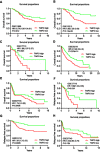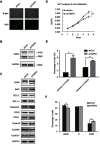Prognostic significance and biological function of Lamina-associated polypeptide 2 in non-small-cell lung cancer
- PMID: 31190881
- PMCID: PMC6529027
- DOI: 10.2147/OTT.S179870
Prognostic significance and biological function of Lamina-associated polypeptide 2 in non-small-cell lung cancer
Abstract
Purpose: Lamina-associated polypeptide 2 (LAP2; encoded by TMPO), is a nuclear protein that may affect chromatin regulation and gene expression through dynamically binding to nuclear lamin. TMPO (LAP2) plays dual roles of either suppressing or promoting proliferation of cells, depending on the status of the cell. It has been reported that TMPO is up-regulated in various cancer types. However, its function in lung cancer has not been studied yet. Materials and methods: A series of clinical microarray datasets for lung cancer were investigated to demonstrate the expression of TMPO. The transcription of TMPO gene in human lung cancer was analyzed using Oncomine platform (www.oncomine.org) according to the standardized procedures described previously. Four separate datasets (Hou Lung, Okayama Lung, Beer Lung, and Garber Lung) were analyzed. Results: Here, we show that TMPO is over-expressed in lung cancer tissues, and that a high level of TMPO indicates a poor prognosis in lung cancer patients. Knockdown of TMPO in lung cancer cells inhibits cell proliferation and induces apoptosis. Also, down-regulation of TMPO leads to an impaired metastatic ability of tumor cells. A nude mice tumor model show that knockdown of TMPO suppresses tumor formation in vivo. Conclusion: Collectively, this study suggests TMPO as an oncogene and a novel prognostic gene in lung cancer.
Keywords: LAP2; TMPO; non-small-cell lung cancer; oncogene; prognostic factor.
Conflict of interest statement
The authors report no conflicts of interest in this work.
Figures






References
LinkOut - more resources
Full Text Sources
Miscellaneous

